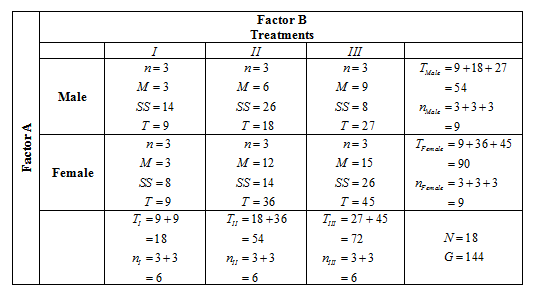
The following data are from a two-factor study examining the effects of three treatment conditions on males and females.
a. Use an ANOVA with
b. Test the simple main effects using
| Treatment | ||||
| I | II | III | ||
| 1 | 7 | 9 | ||
| Male | 2 | 2 | 11 | |
| 6 | 9 | 7 | ||
| Factor A: Gender | ||||
| 3 | 10 | 16 | ||
| 1 | 11 | 18 | ||
| 5 | 15 | 11 | ||
| Female | ||||
- If the mean differences of the treatments are different.
- Test the simple main effects to evaluate the difference between males and females for each treatment.
Answer to Problem 21P
Solution:
- For these data, gender (Factor A) and treatment (Factor B) have significant effect. These data do not produce a significant interaction. This means, that the effect of treatment does not depend on the gender.
- There is a significant difference between males and females in treatments II and III but not in treatment I.
Explanation of Solution
Given Info:

Formula used:
The degrees of freedoms are:
The sums of squares are:
The MS values needed for the F-ratios are:
The F-ratios are:
Calculation:
Part a:
For a two-factor study, there are three separate hypotheses, the two main effects and the interaction.
For Factor A, the null hypothesis states that there is no difference in the scores for male vs. female. In symbols,
For Factor B, the null hypothesis states that there is no difference in the scores at different treatments. In symbols,
For the
The degrees of freedoms are:
The sums of squares are:
The MS values needed for the F-ratios are:
The F-ratios are:
The two factor ANOVA table is shown below:
| Source | SS | df | MS | F |
| Between Treatments | 360 | 5 | ||
| Factor | 72 | 1 | 72 | 9.00 |
| Factor | 252 | 2 | 126 | 15.75 |
| | 36 | 2 | 18 | 2.25 |
| Within Treatments | 96 | 12 | 8 | |
| Total | 456 | 17 |
From F table, at
Part b:
We test the simple main effect of factor A for each level of factor B.
For treatment I:
| Treatments I | ||
| Male | Female | |
| | | |
There is no significant difference between males and females in treatment I.
For treatment II:
| Treatments II | ||
| Male | Female | |
| | | |
There is significant difference between males and females in treatment II.
For treatment III:
| Treatments III | ||
| Male | Female | |
| | | |
There is significant difference between males and females in treatment III.
Conclusion:
- There is a significant main effect for gender (Factor A) and treatment (Factor B) but there is no significant interaction.
- There is a significant difference between males and females in treatments II and III but not in treatment I.
Justification:
Since
Since
Since
Want to see more full solutions like this?
Chapter 14 Solutions
EP STATISTICS F/THE BEHAV.SCI.-MINDTAP
 Glencoe Algebra 1, Student Edition, 9780079039897...AlgebraISBN:9780079039897Author:CarterPublisher:McGraw Hill
Glencoe Algebra 1, Student Edition, 9780079039897...AlgebraISBN:9780079039897Author:CarterPublisher:McGraw Hill
